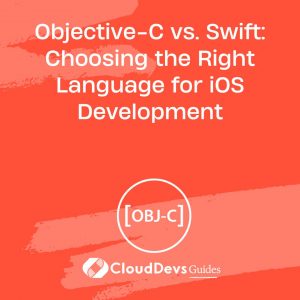Objective-C vs. Swift: Choosing the Right Language for iOS Development
When it comes to developing iOS applications, choosing the right programming language is crucial. In the past, Objective-C was the primary language for iOS development. However, since its introduction in 2014, Swift has gained immense popularity and become the language of choice for many developers. In this blog, we will compare Objective-C and Swift to help you make an informed decision about which language is best suited for your iOS development projects.
1. Overview of Objective-C:
Objective-C has been the primary programming language for iOS development for many years. It is a superset of the C programming language with added object-oriented capabilities. Let’s explore some key aspects of Objective-C:
1.1 Syntax and Structure:
Objective-C syntax can appear verbose and complex to developers coming from other programming languages. It uses square brackets extensively for method calls and message passing. Here’s an example:
objective NSString *message = [[NSString alloc] initWithFormat:@"Hello, %@!", name];
1.2 Learning Curve:
Objective-C has a steep learning curve, especially for developers who are new to object-oriented programming or come from languages with different syntaxes. Understanding concepts like memory management using retain counts and manual memory allocation can be challenging.
1.3 Community and Resources:
Objective-C has a vast and mature community that has built numerous libraries, frameworks, and resources over the years. This extensive ecosystem provides developers with a wide range of options to enhance their iOS projects.
1.4 Interoperability:
One significant advantage of Objective-C is its compatibility with C and C++ code. This allows developers to seamlessly integrate existing libraries or leverage platform-specific functionalities when needed.
2. Introduction to Swift:
Swift was introduced by Apple in 2014 as a modern, safe, and efficient alternative to Objective-C. It was designed to improve developer productivity and code maintainability. Let’s take a closer look at Swift:
2.1 Syntax and Structure:
Swift features a more concise and expressive syntax compared to Objective-C. It eliminates the need for using square brackets and introduces features like optionals, closures, and generics. Here’s an equivalent example in Swift:
swift let message = String(format: "Hello, %@!", name)
2.2 Learning Curve:
Swift has a relatively lower learning curve, especially for developers who are already familiar with modern programming languages like C#, Java, or JavaScript. Its clean syntax and language features make it easier to read, write, and maintain code.
2.3 Community and Resources:
Although Swift is a younger language, it has gained a significant community following and a rapidly growing ecosystem. Many popular libraries and frameworks have been rewritten in Swift, and new ones continue to emerge.
2.4 Performance:
Swift is designed to be fast and efficient. It employs modern optimization techniques and benefits from advancements in compiler technology. In certain scenarios, Swift code can outperform equivalent Objective-C code.
3. Advantages of Objective-C:
3.1 Mature Language:
Objective-C has been around for decades and has a proven track record in iOS development. It has undergone extensive testing and refinement, making it a reliable choice for large-scale projects.
3.2 Legacy Codebases:
If you’re working on a project with an existing Objective-C codebase, sticking with Objective-C may be the best choice. Swift and Objective-C code can coexist within the same project, allowing for a gradual migration to Swift if desired.
3.3 Third-Party Library Support:
Objective-C has a vast collection of third-party libraries and frameworks that have been developed over the years. If your project heavily relies on these libraries, sticking with Objective-C may save you from porting or finding alternatives.
4. Advantages of Swift:
4.1 Modern Language Features:
Swift introduces many modern language features like optionals, generics, type inference, and functional programming concepts. These features enhance code readability, reduce common programming errors, and improve overall developer productivity.
4.2 Safety and Reliability:
Swift was designed with safety in mind. It eliminates common programming errors by enforcing stricter rules on memory management and nullability. Swift also provides powerful tools like Optionals and Result types to handle possible nil values and error conditions.
4.3 Performance:
While Objective-C is known for its performance, Swift has made significant strides in this area. Thanks to its advanced compiler optimizations and modern language design, Swift code can often execute faster and with lower memory footprint than equivalent Objective-C code.
5. Choosing the Right Language:
When deciding between Objective-C and Swift, consider the following factors:
5.1 Project Requirements:
Assess the specific requirements of your project. If you’re working with an existing Objective-C codebase or need to integrate with legacy libraries, Objective-C may be the more practical choice. If you prioritize modern language features and future maintainability, Swift is a strong contender.
5.2 Team Experience and Skills:
Evaluate the skill sets and experience of your development team. If they are proficient in Objective-C or have extensive experience with legacy codebases, sticking with Objective-C might be the smoother transition. If your team is open to learning new technologies and Swift, it could be the more favorable choice.
5.3 Future Development Plans:
Consider your long-term goals for the project. If you anticipate continued development and want to leverage the latest iOS features and frameworks, adopting Swift may provide better long-term support and productivity.
Conclusion:
Objective-C and Swift are both powerful languages for iOS development, each with its own strengths and advantages. While Objective-C offers compatibility with legacy codebases and an extensive library ecosystem, Swift provides modern language features, enhanced safety, and improved performance. Ultimately, the choice between Objective-C and Swift depends on your project requirements, team skills, and long-term goals. Whichever language you choose, both offer the capabilities to build exceptional iOS applications.
Table of Contents









